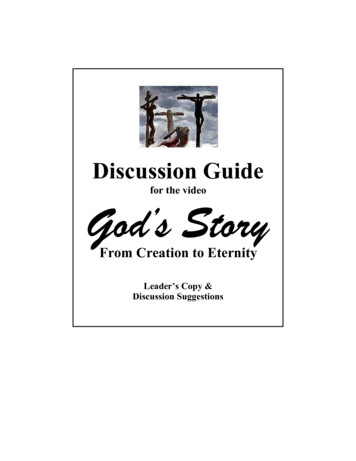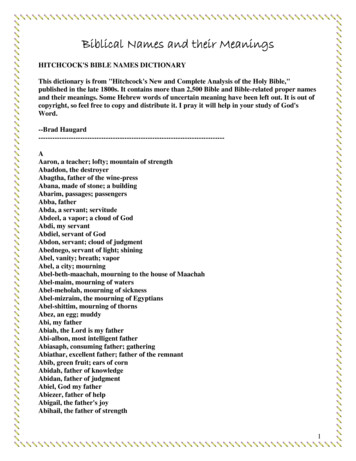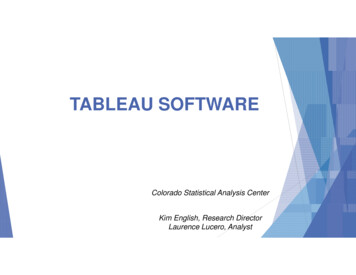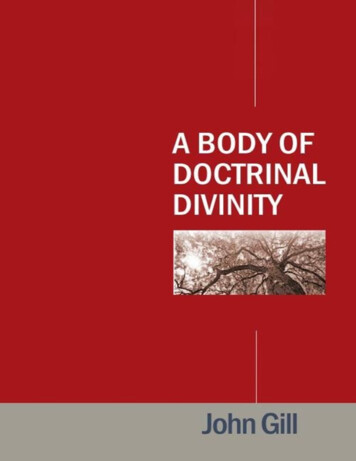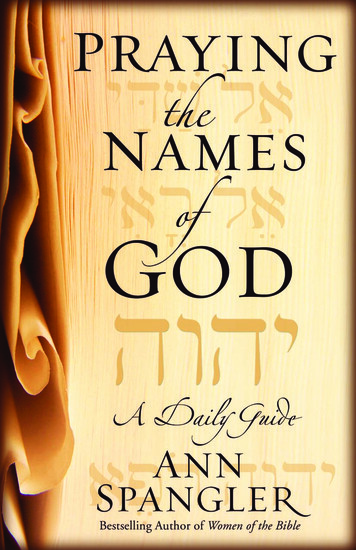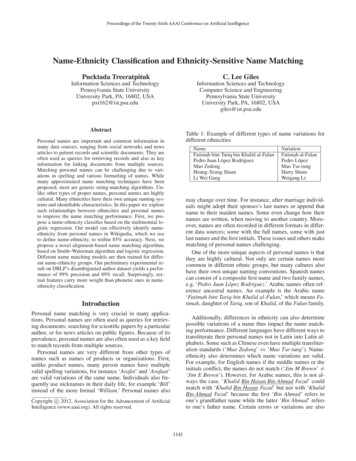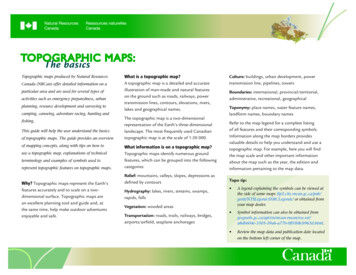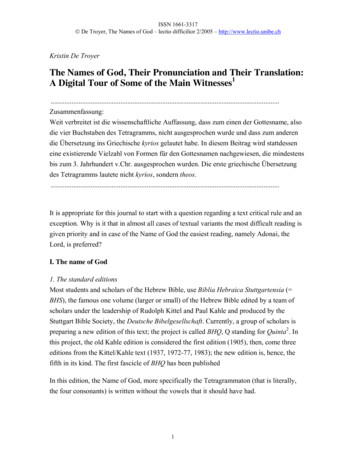
Transcription
ISSN 1661-3317 De Troyer, The Names of God – lectio difficilior 2/2005 – http://www.lectio.unibe.chKristin De TroyerThe Names of God, Their Pronunciation and Their Translation:A Digital Tour of Some of the Main Witnesses1.Zusammenfassung:Weit verbreitet ist die wissenschaftliche Auffassung, dass zum einen der Gottesname, alsodie vier Buchstaben des Tetragramms, nicht ausgesprochen wurde und dass zum anderendie Übersetzung ins Griechische kyrios gelautet habe. In diesem Beitrag wird stattdesseneine existierende Vielzahl von Formen für den Gottesnamen nachgewiesen, die mindestensbis zum 3. Jahrhundert v.Chr. ausgesprochen wurden. Die erste griechische Übersetzungdes Tetragramms lautete nicht kyrios, sondern theos.It is appropriate for this journal to start with a question regarding a text critical rule and anexception. Why is it that in almost all cases of textual variants the most difficult reading isgiven priority and in case of the Name of God the easiest reading, namely Adonai, theLord, is preferred?I. The name of God1. The standard editionsMost students and scholars of the Hebrew Bible, use Biblia Hebraica Stuttgartensia ( BHS), the famous one volume (larger or small) of the Hebrew Bible edited by a team ofscholars under the leadership of Rudolph Kittel and Paul Kahle and produced by theStuttgart Bible Society, the Deutsche Bibelgesellschaft. Currently, a group of scholars ispreparing a new edition of this text; the project is called BHQ, Q standing for Quinta2. Inthis project, the old Kahle edition is considered the first edition (1905), then, come threeeditions from the Kittel/Kahle text (1937, 1972-77, 1983); the new edition is, hence, thefifth in its kind. The first fascicle of BHQ has been publishedIn this edition, the Name of God, more specifically the Tetragrammaton (that is literally,the four consonants) is written without the vowels that it should have had.1
ISSN 1661-3317 De Troyer, The Names of God – lectio difficilior 2/2005 – http://www.lectio.unibe.chFigure 1:hwhyynFd )jYahwehAdonaiThis one can see on almost every page of BHS (and BHQ – though the name of God doesnot appear in the Book of Esther).See image 1: page of the Biblia Hebraica Stuttgartensia (edited by Karl ELLIGER andothers. Stuttgart 1990), containing Deuteronomy 6:4-22.Most scholars acknowledge that the Tetragrammaton was probably pronounced as Yahweh.Bruce M. Metzger writes: “While it is almost if not quite certain that the Name wasoriginally pronounced ‘Yahweh,’ this pronunciation was not indicated when the Masoretesadded vowel sound to the consonantal Hebrew text. To the four consonants YHWH of theName, which had come to be regarded as too sacred to be pronounced, they attached thevowel signs indicating that in its place should be read the Hebrew word Adonai meaning‘Lord’ (or Elohim meaning ‘God’).”3 He then continues and writes: “Ancient Greektranslators employed the word Kyrios (‘Lord’) for the Name. The Vulgate likewise used theLatin word Dominus (‘Lord’).”4 This argument suffices for the rendering of theTetragrammaton in the English translation, NRSV, with “the LORD”. Metzger states in hisintroduction: “Careful readers will notice that here and there in the Old Testament the wordLORD (or in certain cases GOD) is printed in capital letters. This represents the traditionalmanner in English versions of rendering the Divine Name, the “Tetragrammaton” (see thenotes on Exodus 3.14,15), following the precedent of the ancient Greek and Latintranslators and the long established practice in the reading of the Hebrew Scriptures in thesynagogue.”5Many introductions to the Hebrew grammar will explain the phenomenon that the Name ofGod is not to be read as it is written in the text, but as it is supposed to have been written inthe margins.6 Indeed, in the Hebrew Bible, more precisely in the Masoretic text, theconsonants of the Name of God are written (Ketib, hwhy), but not pointed with itspresumed vowels (hFwOhy:). The vowels that are added to the consonants of theTetragrammaton are the vowels of the word “Adonai” (ynFd )j). When the Masoretes wantedthe readers to read a word differently from the one written in the text (the Ketib), theynotified the readers of the different reading by attaching a circellus (a little circle) on top of2
ISSN 1661-3317 De Troyer, The Names of God – lectio difficilior 2/2005 – http://www.lectio.unibe.chthe Ketib, and by writing the related word, which should be read instead of the Ketib, in themargin. The word in the margin is indicated with a Qof, which is the first letter of the wordQere. Qere stands for “what ought to be read”. As the Name of God, however, occurs onalmost every page, the Masoretes did not add little circelli on every occurrence of theTetragrammaton, and they did not provide its alternative reading – Adonai: alef, daleth,nun, yod – in the margin. The Name of God, however, is supposed to be read for eternityusing the word Adonai.The most decisive argument for the replacement of the Tetragrammaton by the alternativeAdonai stems from the double expression Adonai and the Tetragrammaton (hwhy ynFd )j,Adonai plus the Tetragrammaton, see for instance Amos 7:1; 8:1, etc.). In case of thesedouble expressions, the vowels of the Qere are not the vowels of Adonai, but of Elohim(MyihwOl)v), turning the double expression into Adonai Elohim (hwOhye ynFd )j,, Adonai Elohim)instead of Adonai Adonai. According to some scholars, the Masoretes wanted to avoid therepetition of Adonai after the title Adonai, thus avoid the reading Adonai Adonai. Theyinstead filled out the vowels of the Tetragrammaton with the vowels of the word Elohim,creating the reading Adonai Elohim instead of Adonai Adonai. This accordingly proves thatthe Tetragrammaton was normally read as Adonai.A small operation, however, is needed in order to read this alternative substitute of theName of God, namely Elohim. Indeed, in order to come to Elohim one has to first turn thehatef segol into a sewa and second delete the holem – for non-Hebraist readers, this meansturning the e-vowel into a non-vowel and dropping the o-vowel. The only vowels that areactually in all the manuscripts – and thus the only vowel that reminds the reader of thealternative Elohim – is the hireq – the i-vowel.7 This small operation takes me to thevocalization of Adonai in the manuscripts.2. What does one read in old codices, such as Codex Leningrad and Codex Aleppo?Most of the printed Hebrew Bibles are based on Codex Leningrad, a codex dated to1008/1009, located at the library of St. Petersburg. This Codex is the oldest completeHebrew bible. Most scholarly editions of the Bible are based on this Codex.8 The usualform of the Name of God, however, in Codex Leningrad is hwFhy: and not hFwOhy.:3
ISSN 1661-3317 De Troyer, The Names of God – lectio difficilior 2/2005 – http://www.lectio.unibe.chSee image 2: page of Codex Leningradensis. A Facsimile Edition (edited by David NoelFreedman and others. Grand Rapids and Leiden 1998) containing Deuteronomy 5:31b6:22a.In other words, there is a holem, an o-sound, missing in the printed form of theTetragrammaton. The first form, hwFhy: can be read as the Aramaic noun )mF#:, the name,i.e. the Divine Name9. The Masoretes, thus, wanted the readers to read the Tetragrammatonas “ha-shema”, in Hebrew “ha-shem”, the Name.Figure 2:hwFhy:hwFhy:not hFwOhy:.is the Aramaic word )mF#: the NameIndeed, like many Jewish readers of the Bible today do, God is referred to in the margins ofthe Masoretic Bible as “ha-shema”, the Jewish Aramaic word for the Name. The oldestcomplete copy of the Hebrew Bible does hence, not render the Tetragrammaton with “theLord,” but with “the Name”! Similarly, Codex Aleppo and the editions of the rabbinicBible have “the Name” instead of “Adonai”.10 I acknowledge that there are a coupleexceptions to this rule, namely a couple of places where Codex L indeed has Adonai asQere, instead of The Name (see for instance, Ex 3:2).11 I am also aware that there arescholars who try to explain the vowels under the Tetragrammaton as a derivative fromAdonai. They claim that the holem (‘o’) was deliberately omitted from the vowels ofAdonai as to make the reading and thus pronunciation of the Tetragrammaton completelyimpossible.12 It is, however, much easier to explain the vowels under the Tetragrammatonas referring to the word “the Name”. When the Tetragrammaton is, however, preceded bythe title Adonai, it is read as Elohim.3. Was the Name pronounced or not?There is no explanation as to why the Tetragrammaton was no longer pronounced.Moreover, all hypotheses regarding the origins of the Ketib/Qere phenomenon arespeculative.13 In the Jewish tradition, there are plenty of statements regarding the nonpronunciation of the Name of God. In the Mishna Tractacte Sanhedrin X,1, for instance, itis clearly stated that the Name of God can not be pronounced.14 Only the High Priest, morespecifically on Yom Kippur, the Day of Atonement, can utter the Name of God. All theother Jews are not supposed to pronounce the Name of God.4
ISSN 1661-3317 De Troyer, The Names of God – lectio difficilior 2/2005 – http://www.lectio.unibe.chFrom a difference between the Masoretic text of the Hebrew Bible and its Greek(Septuagint) translation, Martin Rösel deduces that only by the time of the Greektranslation of the Book of Leviticus the Tetragrammaton was no longer pronounced.15According to most scholars this was somewhere at the end of the third century BCE.16 TheSeptuagint of Leviticus reads: “And he that names the name of God, let him die the death”,whereas the Hebrew text can be read as “he who uses the name of God in vain, .”.17 Thereis also the Isaiah Qumran scroll (1QIsa) that reads Adonai in 3,7 where the Masoretic texthas the Tetragrammaton.18 This means that by the late second century BCE, the presumeddate of the Isaiah Scroll, the Tetragrammaton might have been read as Adonai.19The “Qumranites” were vehemently opposing the pronunciation of the name of God. 1QS –the Rule of the Community – reads in vi, 27-vii,1-2: “Whoever enunciates the Name (whichis) honoured above all [ ] whether blaspheming, or suddenly overtaken by misfortuneor for any reason, { } or reading a book, or blessing, will be excluded and shall not goback ever to the Community council”.20 Thus, beginning in the second century BCE, thereseems to have been the beginning of the establishment of the tradition of the nonpronunciation of the Name of God. Consequently, it can be said that up till the secondcentury BCE, the Name of God was pronounced. The Masoretes further propagated thenon-pronunciation of the Tetragrammaton and promoted the use of the alternatives such as“the Name” and/or “Adonai”.II. The Names of GodThere are two important collections of data that one has to take into account when dealingwith the name of God: The Elephantine Papyri and the Samaritan Papyri from the WadiDaliyeh. They show that the following names of God were in use.Figure 3:YHWHYHW (or: YHH)YHYahvehYaho (or Yahu)YaThe Elephantine papyri date to the fifth century BCE, the Wadi Daliyeh papyri stem fromthe fourth century BCE The Elephantine papyri contain the correspondence from the Jewishofficials of the Elephantine community to the officials in Samaria and Jerusalem regardingthe rebuilding of their recently destroyed temple.21 Unfortunately, the responses to these5
ISSN 1661-3317 De Troyer, The Names of God – lectio difficilior 2/2005 – http://www.lectio.unibe.chletters were never found. The Wadi Daliyeh papyri are official documents that were takeninto the caves along the river by a group of Samaritans who tried to escape from therevenge of Alexander the Great. Most of these documents are legal papers.22 In bothcollections, one can read the name of God as Yaho (or Yahu) and Ya.23 For the name ofGod written with three consonants, see for instance, The Elephantine Papyri ( EP) B19,English translation, recto, line 11 ( p. 140, line 9): . the Temple of YHW.24 and theWadi Daliyeh Samaria Papyri ( WDSP) 8, p. 88, line 7: . to Mikayahu. , the last part ofthe person’s name is the three-letter name of God ‘yahu’(YHW).25See image 3: map of Egypt,26 Elephantine is located at the first cataract of the Nile.See image 4: Porten, Bezalel: The Elephantine Papyri in English. Three Millennia of crosscultural continuity and change. Leiden 1996, B19, p. 140, line 9.See image 5: map of Israel, Persian times.27See image 6: Wadi Daliyeh Samaritan Papyri 8, p. 88, line 7.The Wadi Daliyeh papyri offer also evidence for a two-letter form of the Name of God.See, for instance, WDSP 15, p. 104, line 2: Deliyah, the last part is the two-letter name ofGod, written YH.28See image 7: Wadi Daliyeh Samaritan Papyri 15, p. 104, line 2The shorter forms of the name of God seem also to be pronounced independently ofpersonal names. The Samaritans thus seem to have pronounced the Name of God as Jaho orJa. That the shorter names of God were pronounced is also mentioned by Theodoretus. Inhis work on Exodus, more precisely in Questio 15, he speaks about the pronunciation of theTetragrammaton. He states that the Samaritans pronounced it Iabe/, whereas the Jewspronounced it Ia/.29 The shorter name of God is also used in the Bible. An obvious exampleis the short phrase “Allelujah” (praise to Jah).Looking at the data, I do not see evidence anywhere in the manuscripts that the differentforms of the Name of God were not to be pronounced. There are neither special signs thatwere attached to the grammata indicating its non-pronunciation nor special remarks madeabout the different names of God, nor special scripts used. To the contrary, short phraseslike Allelujah and the personal names, with the two and three-letter names of God seem to6
ISSN 1661-3317 De Troyer, The Names of God – lectio difficilior 2/2005 – http://www.lectio.unibe.chsuggest the use and the pronunciation of the three- and two-letter, if not also of the fourletter names of God30 from the fifth century BCE to at least the third century BCE, both inEgypt and in Palestine (Samaria). Now, one could object to this view and state that thepeople of Elephantine and Samaria are not “true” Jews and thus not represent Jewishpractice in Judah. Instead of going into this discussion, I will move to what could belabeled “more or typical Jewish” documents and ask the question whether or not and howthe Name of God was pronounced in Jewish circles of the second century BCE andfollowing.III. Qumran Ways of Indicating the Names of God1. Hebrew Scrolls from QumranMost of the Jewish witnesses from the second century BCE to the first century CE stemfrom the Qumran community. As not all the texts were written by members of thecommunity, but brought into the community, they can function to a certain extent aswitnesses to the practices of Jews in Palestine in general. There are, however, alsodocuments that can be characterized as typical Qumran community, such as the CommunityRule. In the Community Rule, there was a prohibition on pronouncing the Name of God.But, if the Name was not to be pronounced, how were the readers informed about this nonpronunciation?First, in many scrolls from the Judean Desert the Tetragrammaton is written in paleoHebrew script. According to Emanuel Tov, writing the Tetragrammaton in paleo-Hebrewscript is characteristic of the Qumran community. 31 Tov links the use of theTetragrammaton with the sacred character bestowed on paleo-Hebrew letters. The sacredcharacter of the letters reflects in a sense the sacredness that embodies the divine nameitself.32 See for instance the Habakuk scroll.See image 8: 1QpHab, plate XI, line 10 (as the permission for publication of this image didnot include electronic publishing, I have enclosed a drawing of it based on John C. Trever,Scrolls from Qumran Cave I: The Great Isaiah Scroll, The Order of the Community, ThePesher of Habakkuk, Jerusalem: The Albright Institute of Archaeological Research and theShrine of the Book, 1974, p. 81, Plate XI).33Moreover, the Tetragrammaton in paleo-Hebrew script appears in different sorts of texts,such as: Biblical texts, rewritten Biblical texts, and non-biblical sectarian compositions.347
ISSN 1661-3317 De Troyer, The Names of God – lectio difficilior 2/2005 – http://www.lectio.unibe.chThis means that writing in paleo-Hebrew script is a very familiar and common way ofwriting the Name of God in the Qumran community and outside of it. Tov also points to thefact that not only the Tetragrammaton, but also the names El(ohim) and Sabaoth, with orwithout prefixes and suffixes, are often written in paleo-Hebrew script.See image 9: 1QH, fragment 35, drawing by Kristin De Troyer, based on the edition:Dominique Barthélemy and Jozef Tadeusz Milik, Qumran Cave 1 (Discoveries of theJudean Desert, 1), Oxford: Clarendon Press, 1955, Plate XXXI, fragment 35.This is an important element, for it shows that not only the Tetragrammaton, but also theother names of God were in use and considered special.Moreover, there are among the Dead Sea Scrolls, many different ways of providing for analternative for the Tetragrammaton. There are for instance, the Tetrapuncta: the Name ofGod, most likely the Tetragrammaton, is indicated with four dots. This system is used ineight texts that Tov identifies as belonging to the Qumran scribal school and threeadditional non-Qumran scribal school system-scrolls.35 Although Tov stresses the linkbetween writing the divine names in paleo-Hebrew characters and the Qumran community,he also points to the fact that thirty-three texts do not use any special system for the writingof the divine names. These texts simply write the Tetragrammaton in square Hebrewcharacters.362. The Jewish Greek Scrolls of QumranThe Greek Scrolls of Qumran confront the reader with a complex issue: Are these texts theOld Greek texts of what we now call the Septuagint? Or do they represent a recension ofthe Old Greek text, that is a revision of the Old Greek text to bring it closer to the Hebrewtext of the Bible as it existed in ca. 2nd-1st century BCE The Minor Prophets N ahal H everscroll, dated between 50 BCE to 50 CE, is such a recension. It contains the kaige-recensionof the Septuagint.37 In this scroll, the Tetragrammaton is written in paleo-Hebrew script.38See image 10: N ahal H ever, Minor Prophets Scroll, col. 28-29 [ Plate XVI, fragment b],PAM 40.561[530], drawing by Kristin De Troyer, based on the edition: see Emanuel Tov,with the collaboration of Robert A. Kraft and a contribution of P.J. Parsons, The GreekMinor Prophets Scroll from Nahal Hever (8HevXIIgr) (The Seiyâl Collection I)(Discoveries in the Judaean Desert, VIII), Oxford: Clarendon Press, 1990, Plate XVI,fragment b.8
ISSN 1661-3317 De Troyer, The Names of God – lectio difficilior 2/2005 – http://www.lectio.unibe.chThe problem with a recension is that one does not know what is the original form and whatthe recension. Hence, is the paleo-Hebrew Tetragrammaton secondary – a part of therecension – or proof of the Old Greek text? This debate has not yet been solved.In Qumran, among the Greek texts, is however also the 4QpapLXXLevb.39See image 11: 4QpapLXXLevb PAM 43.559; fragment 20, line 4, drawing by Kristin DeTroyer, based on the edition, see: Patrick W. Skehan, Eugene Ulrich, Judith E. Sanderson,with a contribution by P.J. Parsons, Qumran Cave 4. IV. Paleo-Hebrew and Greek BiblicalManuscripts (Discoveries of the Judaean Desert, IX), Oxford: Clarendon Press, 1992, p.174 and Plate XL, fragment 20).In this Old Greek text of the Book of Leviticus, the name of God is written IAW. Skehan,the editor of the text, suggests that the reading IAW is more original than kurios: “This newevidence strongly suggests that the usage in question goes back for some books at least tothe beginnings of the Septuagint rendering”.40 That the name of God was simply writtenIAO in the Leviticus scroll is very telling, for it is precisely in the Greek Leviticus scrollthat one reads about the prohibition of naming the Name of God! IAO can be seen as atransliteration of YAHU, the three-letter form of the Name of God. This tradition seems tohave been known by Diodorus Siculus (1st century BCE) who states that the Jewspronounced the Name of God as IAW.41 The appearance of IAO in the Leviticus scroll hasleft many scholars baffled. Is it proof that the Tetragrammaton was still pronounced in thefirst century BCE?3. A Note about the scrolls written in paleo-Hebrew scriptIn the paleo-Hebrew manuscripts of Qumran, the Name of God is simply written in paleoHebrew characters.IV. Data from the Greek, non-Qumranic, tradition421. A Dominant (late) RenderingThe Septuagint is often characterized as a Christian Bible. The Old Greek Bible is,however, a product by and for the Jewish community. It was only in the apologetic periodthat the Septuaginta did indeed become the Christian Bible.43 The Septuaginta, as it waspublished by Alfred Rahlfs (that is the big blue linen volumes of old days and the morerecent one blue small hardcover Septuaginta),44 is based on especially the following9
ISSN 1661-3317 De Troyer, The Names of God – lectio difficilior 2/2005 – http://www.lectio.unibe.chcodices: Codex Vaticanus (4th century CE),45 Codex Alexandrinus (5th century CE),46 andfinally, Codex Sinaiticus (4th century CE).47In Codex Vaticanus, as well as in the other two most important codices, theTetragrammaton is rendered by Kurios,48 more precisely by a truncated form of Kurios,written KC. Indeed the word Kurios is not spelled out, but truncated.49 Kurios, in itstruncated form, seems to be the dominant name of God in at least the documents from thefourth century onwards, although already in use at the end of the second, beginning of thethird century. One can consult the facsimile edition of Codex Vaticanus to see the truncatedform of the Name of God. For this contribution, I have made use of the Schøyen Joshuapapyrus, dated towards the end of the second and beginning of the third century CE50See image 12: Old Greek Joshua Codex, from the Martin Schøyen Collection, MS 2648,Plate XVIII, leaf 2, recto, line 7, 17, and 19.51It is often argued that the contracted forms of Kurios are a Christian invention. In theFragments of the Book of Kings according to the translation of Aquila, the name of God,however, is on one occasion not written in paleo-Hebrew characters, but also truncated asK8U8.52See image 13: the reconstruction of fol. 2 v, line 15.532. Early ExceptionsI already referred to the reading of IAO in the Greek Leviticus papyrus of Qumran.54There is also the Septuagint of the Twelve Minor Prophets where God is labeled‘pantokrator’ whereas the MT has the Tetragrammaton. See for instance LXX Za 9:14.55Moreover, there are other texts, which did not originate in Qumran, that use theTetragrammaton. There is, for instance, the famous Fouad papyrus (P. Fouad 266 Ra848).56 This papyrus has the Tetragrammaton in Aramaic square Hebrew script. There ishowever also a discussion about this manuscript: is it a recension or not? Emanuel Tovnotes: “In PFouad 266, the original Greek scribe left open large spaces for theTetragrammaton indicated by a raised dot on each side of the space. Then, at a later time,the Tetragrammaton was added, possibly by another scribe, in the indicated spaces.”57Pietersma, in his plea for regarding Kurios as the oldest Name of God in the Old Greektext, states that there is plenty of room for the reading Kurios, but that the second scribe10
ISSN 1661-3317 De Troyer, The Names of God – lectio difficilior 2/2005 – http://www.lectio.unibe.chfilled out the Tetragrammaton in small Aramaic square Hebrew letters. Pietersma followsHanhart who claims that Fouad already contains some pre-hexaplaric corrections towards aHebrew text (which would have had the Tetragrammaton).58More important for this contribution is, however, the existence of several manuscripts thathave Theos and not Kurios. These manuscripts are rather important, especially as (Jewish)pre-hexaplaric corrections seem less probable – though some scholars have pointed to apossible influence of the Jewish tradition on the Greek texts of the Oxyrhynchus area.59There is, for instance, the Genesis papyrus from the Oxyrhynchus area, (P.Oxy 656),60dated to the third century. In four places of the Genesis text, the word Kurios has not beenused,61 whereas the Hebrew text clearly has the Tetragrammaton. In one out of the fourplaces, the scribe left an empty space, which a second later scribe filled out with Kurios.62Twice, the second scribe also inserted at the end of the line the word Kurios, where therewas no space left for the Name of God in the Greek text.63 Finally, in one place the firstscribe simply wrote Theos.64 In this passage, the MT text reads the Tetragrammaton (Gen24,40). The first and the second scribe both did not use a contracted form of the Name ofGod or of Theos, but simply wrote out Theos or – the second hand – Kurios.65Theos, in a non-contracted form, also appears in PFouad 266a, the Genesis fragment (datedto the first century BCE),66 in PFouad 266c, the Deuteronomy fragment, dated to the latefirst century BCE,67 and in POxy 4443, the LXX Esther text from the 1st-2nd century CE68Theos, albeit in a contracted form, also appears in P.Amh.1, n.3, an Aquila text of Genesisfrom the third century CE69Another alternative can be seen in the Oxyrhynchus papyrus of Job (POxy 3522, LXX Job42:11-12). It has the Tetragrammaton in Paleo-hebrew script.70See image 14 (link to The Oxyrhynchus Papyri Project, Oxford): POxy 3522, LXX Job42:11-12. column 1, line 2 and 5, the image is produced by Dr. Dirk Obbink and TheOxyrhynchus Papyri Project, Oxford. This papyrus is dated to the first century CE.Another Oxyrhynchus papyrus, POxy 1007 with text from Genesis 2-3 (late third century),does not have the Tetragrammaton, but a double Yod, with a horizontal stroke through theletters making it look like a double Greek Zeta, followed by a contracted Theos. Indicatingthe Name of God with a double yod has become standard in the later rabbinic tradition. Stilltoday, when dealing about God, Jews write “yod yod.”71 Here, I would also like to draw the11
ISSN 1661-3317 De Troyer, The Names of God – lectio difficilior 2/2005 – http://www.lectio.unibe.chattention to the use of four dods surmounted by four yods in the Qumran manuscript 1QScol.8.72See image 15: MS 1630, 1QS col. 8, mid column left leaf, line 7 from below.There are, thus, many exceptions to the use of Kurios in the Old Greek papyri and texts.What seems to have been an important exception, or maybe a trail of an older tradition, isthe use of Theos, and this in a non-contracted form, as the oldest rendering of theTetragrammaton. This has consequences for the debate about the Nomina Sacra.73As a conclusion, it suffices to say that in old Hebrew and Greek witnesses, God has manynames. Most if not all were pronounced till about the second century BCE. As slowlyonwards there developed a tradition of non-pronunciation, alternatives for theTetragrammaton appeared. The reading Adonai was one of them. Finally, before Kuriosbecame a standard rendering Adonai, the Name of God was rendered with Theos.12
ISSN 1661-3317 De Troyer, The Names of God – lectio difficilior 2/2005 – http://www.lectio.unibe.chList of imagesImage 1: page of the Biblia Hebraica Stuttgartensia (edited by Karl ELLIGER and others.Stuttgart 1990), containing Deuteronomy 6:4-22.13
ISSN 1661-3317 De Troyer, The Names of God – lectio difficilior 2/2005 – http://www.lectio.unibe.chImage 2: page of Codex Leningradensis. A Facsimile Edition (edited by David NoelFreedman and others. Grand Rapids and Leiden 1998) containing Deuteronomy 5:31b6:22a.14
ISSN 1661-3317 De Troyer, The Names of God – lectio difficilior 2/2005 – http://www.lectio.unibe.chImage 3: map of Egypt, Elephantine is located at the first cataract of the Nile: SilviaSchroer, Othmar Keel, Die Ikonographie Palästinas/Israels und der Alte Orient. EineReligionsgeschichte in Bildern, Bd. 1. Vom ausgehenden Mesolithikum bis zurFrühbronzezeit. Freiburg/CH 2005, S. 2.15
ISSN 1661-3317 De Troyer, The Names of God – lectio difficilior 2/2005 – http://www.lectio.unibe.chImage 4: Porten, Bezalel: The Elephantine Papyri in English. Three Millennia of crosscultural continuity and change. Leiden 1996, B19, p. 140, line 9.16
ISSN 1661-3317 De Troyer, The Names of God – lectio difficilior 2/2005 – http://www.lectio.unibe.chImage 5: map of Israel, Persian times: J. Maxwell Miller, John H. Hayes: A History ofAncient Israel and Judah. London 1986, 461.17
ISSN 1661-3317 De Troyer, The Names of God – lectio difficilior 2/2005 – http://www.lectio.unibe.chImage 6: Wadi Daliyeh Samaritan Papyri 8, p. 88, line 7Image 7: Wadi Daliyeh Samaritan Papyri 15, p. 104, line 218
ISSN 1661-3317 De Troyer, The Names of God – lectio difficilior 2/2005 – http://www.lectio.unibe.chImage 8: 1QpHab, plate XI, line 10 (as the permission for publication of this image did notinclude electronic publishing, I have enclosed a drawing of it based on John C. Trever,Scrolls from Qumran Cave I: The Great Isaiah Scroll, The Order of the Community, ThePesher of Habakkuk, Jerusalem: The Albright Institute of Archaeological Research and theShrine of the Book, 1974, p. 81, Plate XI).19
ISSN 1661-3317 De Troyer, The Names of God – lectio difficilior 2/2005 – http://www.lectio.unibe.chImage 9: 1QH, fragment 35, drawing by Kristin De Troyer, based on the edition:Dominique Barthélemy and Jozef Tadeusz Milik, Qumran Cave 1 (Discoveries of theJudean Desert, 1), Oxford: Clarendon Press, 1955, Plate XXXI, f
'Lord' (or Elohim meaning 'God')."3 He then continues and writes: "Ancient Greek translators employed the word Kyrios ('Lord') for the Name. The Vulgate likewise used the Latin word Dominus ('Lord')."4 This argument suffices for the rendering of the Tetragrammaton in the English translation, NRSV, with "the LORD".



![What's in a Name? Book of Mormon Language, Names, and [Metonymic] Naming](/img/33/whats-in-a-name-book-of-mormon-language-names-and-metonymic.jpg)
